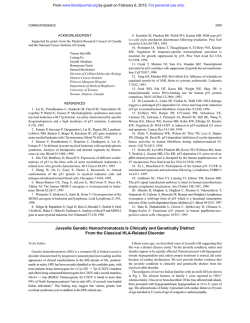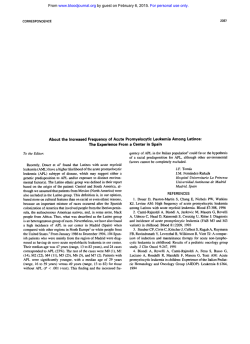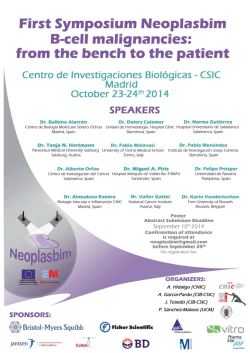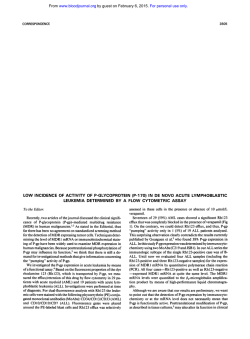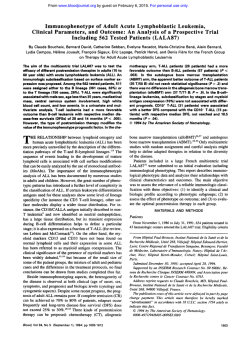
Differentiating Juvenile Myelomonocytic Leukemia From
From www.bloodjournal.org by guest on February 6, 2015. For personal use only. CORRESPONDENCE 365 REFERENCES 1. Bernardi F, Faioni EM, Castoldi E, Lunghi B, Castaman G, Sacchi E, Mannucci PM: A factor V genetic component differing from Factor V R506Q contributes to the activated protein C resistance phenotype. Blood 90:1552, 1997 2. Lunghi B, Iacoviello L, Gemmati D, di Iasio MG, Castoldi E, Pinotti M, Castaman G, Redaelli R, Mariani G, Marchetti G, Bernardi F: Detection of new polymorphic markers in the factor V gene: Association with factor V levels in plasma. Thromb Haemost 75:45, 1996 3. Jenny RJ, Pittman DD, Toole JJ, Kriz RW, Aldape RA, Hewick RM, Kaufman RJ, Mann KG: Complete cDNA and derived amino acid sequence of human factor V. Proc Natl Acad Sci USA 84:4846, 1987 4. Tishkoff SA, Dietzsch E, Speed W, Pakstis AJ, Kidd JR, Cheung K, Bonne´-Tamir B, Santachiara-Benericetti AS, Moral P, Krings M, Paabo S, Watson E, Risch N, Jenkins T, Kidd KK: Global patterns of linkage disequilibrium at the CD4 locus and modern human origins. Science 271:1380, 1996 Differentiating Juvenile Myelomonocytic Leukemia From Infectious Disease To The Editor: fied herpesviruses, might contribute to understanding pathogenesis as well as to diagnosis and management. Two recent articles in BLOOD1,2 review the findings and outcome of juvenile myelomonocytic leukemia (JMML). Both omit an important aspect of JMLL: its differentiation from infectious disease. Several disseminated microbial infections of infancy can result in persistent fever, failure to thrive, hepatosplenomegaly, skin lesions, anemia, thrombocytopenia, and myelomonocytosis, including Epstein-Barr virus (EBV), cytomegalovirus (CMV), human herpes virus-6 (HHV-6), histoplasma, mycobacteria, and toxoplasma. Thorough investigation for infection is needed in infants with these findings to avoid erroneous diagnosis and mistaken interventions. Herrod et al3 reported two infants with persistent EBV infection and findings consistent with JMML, including increased numbers of F and i cells and abnormal granulocyte-macrophage colony formation in vitro. Both recovered without treatment and remained well. This raises the possibility that some of the long-term survivors reported by Niemeyer et al and Arico et al had similar infections rather than leukemia. Neonatal CMV and HHV-6 infections can also mimic JMML.4,5 Might erroneous diagnosis account for the better prognosis reported for patients with JMML who are less than 6 months old?2 The excellent reviews of Niemeyer et al and Arico et al suggest that JMML represents a group of diseases rather than a single entity. Careful investigation for microbial associations, including more recently identi- Donald Pinkel Driscoll Children’s Hospital Corpus Christi, TX REFERENCES 1. Niemeyer CM, Arico M, Basso G, Biondi A, Cantu´ Rajnoldi A, Creutzig U, Haas O, Harbott J, Hasle H, Kerndrup G, Locatelli F, Mann G, Stollmann-Gibbels B, Van’t Veer-Korthof, van Wering E, Zimmerman M, and members of the European Working Group on Myelodysplastic Syndromes in Childhood: Chronic myelomonocytic leukemia in childhood: A retrospective analysis of 110 cases. Blood 89:3534, 1997 2. Arico M, Biondi A, Pui C: Juvenile myelomonocytic leukemia. Blood 90:479, 1997 3. Herrod H, Dow L, Sullivan J: Persistent Epstein-Barr virus infection mimicking juvenile chronic myelogenous leukemia: Immunologic and hematologic studies. Blood 61:1098, 1983 4. Kirby M, Weitzman S, Freedman M: Juvenile chronic myelogenous leukemia: Differentiation from infantile cytomegalovirus infection. Am J Pediatr Hematol Oncol 12:292, 1990 5. Lorenzana A, Lyons H, Sawaf H, Higgins M, Carrigan D, Emmanuel P: Human herpes virus-6 (HHV-6) infection in an infant mimicking juvenile chronic myelogenous leukemia (JCML). J Pediatr Hematol Oncol 19:370, 1997 Response We are grateful to Dr Pinkel for his carefully considered remarks. We fully agree that some infectious disease can mimic JMML, thus jeopardizing the interpretation of some cases. In particular, Dr Pinkel raises the question of whether some of the long-term survivors we described, in fact, have JMML. Although such suspicion is obviously warranted, our experience indicates that the vast majority of cases that fit the diagnostic picture of JMML represent leukemia and not an infectious process. Even when the patients show rapid recovery with or without ‘‘minimal treatment,’’ reactivation of the disease may occur. In some cases these recurrences have an accelerated phase, mirroring that in patients with rapidly fatal JMML. We cannot rule out infectious diseases as the origin of some of the more unusual cases of JMML that have been reported in the medical literature, but we do not believe these exceptions account for more than 10% of the total number. Perhaps current advances in the diagnosis will help to resolve this intriguing issue. Maurizio Arico` IRCCS Policlinico S. Matteo Pavia, Italy Andrea Biondi Ospedale S. Gerardo Monza, Italy Ching-Hon Pui St Jude Children’s Research Hospital Memphis, TN Response We have recently published the results of a retrospective analysis of 110 children with chronic myelomonocytic leukemia (CMML).1 There has since been an international consensus to rename the disease juvenile myelomonocytic leukemia (JMML). The new term JMML will include all leukemias of childhood previously classed CMML,1,2 juvenile chronic myelogenous leukemia (jCML),3,4 or infantile monosomy 7 From www.bloodjournal.org by guest on February 6, 2015. For personal use only. 366 CORRESPONDENCE Table 1. Criteria for the Diagnosis of JMML Category Suggestive clinical features Minimal laboratory criteria (all 3 have to be fulfilled) Item 1. 2. 3. 4. 5. 1. 2. Criteria requested for definite diagnosis (at least 2) 3. 1. 2. 3. 4. 5. Hepatosplenomegaly (97%) Lymphadenopathy (76%) Pallor (64%) Fever (54%) Skin rash (36%) No Ph chromosome, no bcr-abl rearrangement Peripheral blood monocyte count Ͼ1 ϫ 109/L Bone marrow blasts Ͻ20% Hemoglobin F increased for age Myeloid precursors on peripheral blood smear White blood count Ͼ10 ϫ 109/L Clonal abnormality (including monosomy 7) GM-CSF hypersensitivity of myeloid progenitors in vitro Numbers in parenthesis refer to the percentage of patients with the particular clinical feature.1 Abbreviation: Ph, Philadelphia. syndrome,3 because their clinical and biological similarities suggest that they are spectrums of the same disease. We believe that the broad agreement on nomenclature will facilitate cooperative treatment trials and hasten research on the pathogenesis of JMML. As addressed by Dr Pinkel, the clinical and morphological picture of JMML can be mimicked by a variety of infectious organisms. In addition, granulocyte-macrophage colony-stimulating factor hypersensitivity of myeloid progenitor cells, thought to play a central role in the pathogenesis of JMML,5 has been noted in vitro in children with viral infections.6 A basic tenet for the definition of myeloid leukemias is the demonstration of the clonal origin from a malignant hematopoietic progenitor cell.7 The clonal nature is often inferred by evidence of a chromosomal abnormality or an activating mutation of a protooncogene. In this respect about half of the children with JMML have evidence of a clonal disorder; 35% are known to have a chromosomal abnormality1 and 15% to have a point mutation of the Nras or Kras oncogene in their hematopoietic cells.8 More recently, the study of X-chromosome inactivation patterns showed evidence for monoclonal origin of mononuclear cells in all female JMML patients analyzed.9 In the absence of a marker of clonality, the establishment of the diagnosis JMML and firm exclusion of an infectious origin can be difficult. To address this issue in our retrospective study1 we collected data on the serology for cytomegalovirus (CMV; n ϭ 56), herpes virus type I (HSV; n ϭ 27), and Epstein-Barr virus (EBV; n ϭ 51) from the time of diagnosis. Thirty-eight percent of children were positive for CMV, 44% for HSV, and 47% for EBV. The prevalences of antibodies to these viruses were similar to those observed in normal infant populations in Western Europe.10-13 There were no significant differences in age at diagnosis or length of survival between JMML patients with or without previous or recent CMV, HSV, or EBV infection. Dr Pinkel raises the concern that some of our long-term survivors might have had infections rather than leukemia. Of the seven patients with a survival of more than 5 years without bone marrow transplantation, four have succumbed to their disease (Table 7 in Niemeyer et al1). Of the three remaining patients, one girl currently alive with disease 6.5 years after diagnosis is known to have an Nras mutation (A. Biondi, personal communication). Another patient had monosomy 7 in his bone marrow cells documented twice within 6 months after diagnosis, whereas a normal karyotype was found 4 and 9 years later. He had no evidence of disease when seen last 9.6 years after diagnosis.14 The patient with the longest survival, currently 13 years after diagnosis, had no marker of clonality. His smears and clinical data were thoroughly reviewed, but it cannot be excluded that he suffered from an infection rather than from leukemia. Viral studies from the time of the diagnosis were not available. We agree with Dr Pinkel that a careful investigation for an infectious cause is mandatory in all children suspected as suffering from JMML. Until the chromosomal and molecular abnormalities of the majority of JMML patients with so-called ‘‘normal karyotype’’ have been unraveled, the diagnosis of JMML will have to be based on a number of clinical and laboratory features (Table 1). The suggestive clinical features, the minimal laboratory criteria, and the criteria requested for definite diagnosis may prove to be a guideline in establishing the diagnosis of JMML. For the European Working Group of MDS in Childhood (EWOG-MDS): C.M. Niemeyer, MD Universita¨ts-Kinderklinik Freiburg, Germany S. Fenu, MD Cattedra di Ematologia Universita´ degli Studi di Roma Roma, Italy H. Hasle, MD Aarhus Kommunehospital Aarhus, Denmark G. Mann, MD St Anna Kinderspital Vienna, Austria J. Stary, MD 2nd Medical Faculty, Charles University 2nd Clinic of Pediatrics Pragues, Czech Republic E. van Wering, MD Dutch Childhood Leukemia Study Group The Hague, The Netherlands REFERENCES 1. Niemeyer CM, Arico´ M, Basso G, Biondi A, Cantu´ Rajnoldi A, Creutzig U, Haas O, Harbott J, Hasle H, Kerndrup G, Locatelli F, Mann G, Stollmann-Gibbels B, van’t Veer-Korthof, van Wering E, Zimmermann M, and members of the European Working Group on Myelodysplastic Syndromes in Childhood: Chronic myelomonocytic leukemia in childhood: A retrospective analysis of 110 cases. Blood 89:3534, 1997 2. Castro-Malaspina H, Schaison G, Passe S, Pasquier M, Berger R, Bayle-Weisgerber C, Miller D, Seligmann M, Bernard J: Subacute and chronic myelomonocytic leukemia in children (juvenile CML). Cancer 54:675, 1984 3. Freeman MH, Estrov Z, Chan HSL: Juvenile chronic myelogenous leukemia. Am J Pediatr Hematol Oncol 10:261, 1988 4. Passmore SJ, Hann IM, Stiller CA, Ramani P, Swansbury GJ, Gibbons B, Reeves BR, Chessels JM: Pediatric myelodysplasia: A study of 68 children and a new prognostic scoring system. Blood 85:1742, 1995 5. Emanuel PD, Bates LJ, Castleberry RP, Gualtieri RJ, Zuckerman KS: Selective hypersensitivity to granulocyte-macrophage colonystimulating factor by juvenile chronic myeloid leukemia hematopoietic progenitors. Blood 77:925, 1991 6. Lorenzana A, Lyons H, Sawaf H, Higgins M, Carrigan D, Emmanuel P: Human herpes virus-6 (HHV-6) infection in an infant mimicking juvenile chronic myelogenous leukemia (JCML). J Pediatr Hematol Oncol 19:370, 1997 7. Fialkow PJ, Gartler SM, Yoshida A: Clonal origin of chronic myelocytic leukemia in man. Proc Natl Acad Sci USA 58:1468, 1967 8. Kalra R, Paderanga DC, Olson K, Shannon KM: Genetic analysis is consistent with the hypothesis that NF 1 limits myeloid cell growth through p21ras. Blood 84:3435, 1994 9. Busque L, Gilliland DG, Prchal JT, Sieff CA, Weinstein HJ, Sokol JM, Belickova M, Wayne AS, Zuckerman KS, Sokol L, Castleberry RP, Emanuel PD: Clonality in juvenile chronic myelogeous leukemia. Blood 85:21, 1995 From www.bloodjournal.org by guest on February 6, 2015. For personal use only. CORRESPONDENCE 367 10. Leinikki P, Granstro¨m M-L, Santavuori P, Pettay O: Epidemiology of cytomegalovirus infections during pregnancy and infancy. Scand J Infect Dis 10:165, 1987 11. Ahlfors K, Ivarsson S-A, Johnsson T, Svensson I: Congenital and acquired cytomegalovirus infections. Acta Paediatr Scand 67:321, 1978 12. Stuart-Harris C: The epidemiology and clinical presentation of herpes virus infections. J Antimicrob Chemother 12:1, 1983 13. Lamy ME, Favart AM, Cornue C, Mendez M, Segas M, Bortonboy G: Study of Epstein-Barr virus (EBV) antibodies. Acta Clin Belg 37:281, 1982 14. Stollmann B, Fonatsch C, Havers W: Persistent Ebstein-Barr virus infection associated with monosomy 7 or chromosome 3 abnormality in childhood myeloproliferative disorders. Br J Haematol 60:183, 1985 Hereditary Hyperferritinemia-Cataract Syndrome: Two Novel Mutations in the L-Ferritin Iron-Responsive Element To the Editor: Cazzola et al1 recently reported two kindreds with hereditary hyperferritinemia cataract syndrome (HHCS) associated with novel point mutations within a regulatory stem-loop motif in the L-ferritin mRNA termed the iron-responsive element (IRE). Affected individuals showed a characteristic clinical phenotype of elevated serum ferritin concentration and cataract developing early in life. The proposed pathogenesis of this disorder is that nucleotide substitutions within the IRE disrupt its specific interaction with the cytoplasmic iron regulatory protein (IRP). Failure of optimal IRP-IRE binding in turn leads to failure of suppression of L-ferritin translation. There are now increasing numbers of reports that describe the genotype-phenotype relationship in kindreds with naturally occurring IRE mutations, and as Cazzola et al1 report, the phenotype varies with the position of the mutation in the IRE. These descriptions now provide clinical data that support the structural model of the IRE-IRP interaction deduced from in vitro binding studies using artificially created IRE mutants.2-4 We have identified two further kindreds with HHCS and novel mutations in the L-ferritin IRE that further support this model. Kindred I. The 51-year-old male proband of English origin developed visual symptoms in his mid-thirties from cataracts, but was otherwise asymptomatic. Investigations revealed a serum ferritin of 1,389 µg/L but normal transferrin saturation. Similar abnormalities were noted in the proband’s sister, and liver biopsy specimens from both these individuals showed no iron overload. Sequencing of genomic DNA from the proband showed a heterozygous point mutation that corresponded to a ϩ39 C = U substitution in the L-ferritin mRNA. Kindred 2. The 42-year-old female proband of English origin was investigated for anemia detected at one of her regular blood transfusion sessions. Although her red cell indices and transferrin saturation were consistent with mild iron deficiency, her serum ferritin was elevated at 1,020 µg/L. The proband herself had had previous surgical extraction of cataracts, and there were premature cataracts in 8 other family members. The son of the proband required cataract extraction at 5 years old. Hyperferritinemia was confirmed only in family members with cataract. Analysis of genomic DNA also showed a heterozygous point mutation, this time corresponding to a ϩ36 C = A substitution in the L-ferritin mRNA. This substitution created an Mse I restriction site within the amplified sequence, and restriction digests from additional family members confirmed that the substitution segregated with the hyperferritinemia-cataract phenotype. The nucleotide substitutions detected in kindreds 1 and 2 lie in the apical loop and upper stem of the IRE, respectively (Fig 1). We note that in both kindreds individuals display a severe phenotype, and this is consistent with the observations of Cazzola et al that mutations near the apex of the IRE result in higher serum ferritin concentrations and denser cataracts. These results also comply with data from in vitro binding studies; nucleotide substitutions in the apical loop of the IRE dramatically reduce IRP affinity, consistent with its putative role as the IRP binding site.2,3 Individuals from kindred 1 with a naturally occurring mutation at this site are therefore expected to have a severe defect in L-ferritin regulation. In the case of kindred 2, artificially created Fig 1. Schematic representation of the L-ferritin IRE adapted from Cazzola et al showing the updated distribution of genotypic abnormalities in HHCS. Substitutions ؉39 C = U in kindred 1 and ؉36 C = A lie within the apical loop and upper stem, respectively. (Adapted and reprinted with permission.1) nucleotide substitutions in the IRE upper stem exert a profound effect on IRP binding in vitro, but only if complementary base pairing in the stem is disrupted.4 Pairing of nucleotides may facilitate IRE-IRP binding by maintaining an optimum secondary structure of the IRE. The From www.bloodjournal.org by guest on February 6, 2015. For personal use only. 1998 91: 365-367 Differentiating Juvenile Myelomonocytic Leukemia From Infectious Disease Donald Pinkel Updated information and services can be found at: http://www.bloodjournal.org/content/91/1/365.full.html Articles on similar topics can be found in the following Blood collections Information about reproducing this article in parts or in its entirety may be found online at: http://www.bloodjournal.org/site/misc/rights.xhtml#repub_requests Information about ordering reprints may be found online at: http://www.bloodjournal.org/site/misc/rights.xhtml#reprints Information about subscriptions and ASH membership may be found online at: http://www.bloodjournal.org/site/subscriptions/index.xhtml Blood (print ISSN 0006-4971, online ISSN 1528-0020), is published weekly by the American Society of Hematology, 2021 L St, NW, Suite 900, Washington DC 20036. Copyright 2011 by The American Society of Hematology; all rights reserved.
© Copyright 2026



